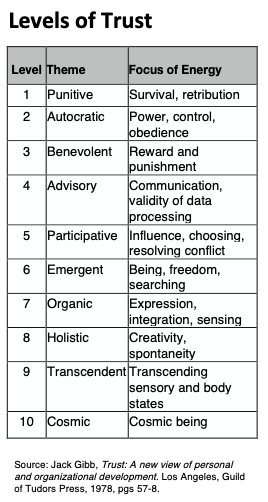Trust Theory
Episode #1 of the course 10 tools for change by Kate Sutherland
Welcome to the course!
I’m Kate Sutherland, founding faculty and executive coach for the Social Innovation Certificate at Simon Fraser University. I consult and coach for transformative change in human systems, and my latest book is We Can Do This!.
Over the next ten days, I’ll introduce ten tools for revolutionizing how we work together. Each one is powerful and used by facilitators and consultants the world over.
I love all the tools and use different combinations all the time. I hope you’ll keep going if one or two don’t resonate. A later one might be game-changing for you!
First Up: Trust Theory
Trust theory is the idea that trust is foundational for higher functioning in all human systems—from our families and friendships to our work teams and societal institutions.
Imagine a spectrum: from high fear to high trust.

Every individual, group, and organization is operating within a particular range along this continuum. The higher the levels of trust, the more creative, innovative, dynamic, and effective the group or organization will be.
In chronically low-trust environments, people “show up” less and less over time. There is an ever-growing gap between what is expressed and what is underneath.
Origins
The author of Trust Theory is Jack Gibb, a psychologist known for his pioneering work integrating theory, research, and practice. He consulted for companies such as AT&T, GM, and Dupont and was director of research at the famous National Training Laboratories in Bethel, Maine. Gibb argued that trust was the most fundamental variable in human dynamics and that increasing trust is the most potent intervention.
Ten Levels of Trust
Gibb identified ten levels of trust. He found that in most group contexts, people are scattered within two to three levels. Where there are wider discrepancies, it’s harder for people to be in the same group! Feel familiar?
See if you can identify the trust level(s) of a group that you are part of based on the table below.

The TORI Framework
Gibb offered “TORI” as a way to name the benefits that higher trust unleashes:
• When there is a high level of Trust, we are freed up to be ourselves and can drop limiting roles and positions.
• Trust naturally leads to Openness—people say what they think, know, care about, and need.
• Trust and Openness lead to Realization—people express and create in ways that are deeply meaningful to them.
• When groups have high levels of Realization, they naturally mature into Interdependence (and community), where boundaries blur, and there is more synergy and effectiveness.
How Do We Increase Trust?
Gibb listed two primary directives:
1. Create a high-quality environment—one that supports people to trust.
2. Choose to trust yourself in a way that lets you be authentic and role free.
Going deeper, it turns out that these two directives are actually two sides of the same coin.
The most powerful lever for creating a high-trust environment lies within each of us: Be trusting! The more we trust life, ourselves, and the group, the more we create a high-quality environment. Trust begets trust!
Unpacking this, we can choose to trust that fundamentally, no matter what happens, we will be okay. We can choose to trust that we are enough. We can choose to trust that the other person will be themselves (not necessarily nice or kind or helpful) and that no matter what they do, fundamentally, at the deepest level, we are fine. Such choices allow us to be open and authentic and to step out from behind the mask of “manager” or “boss.”
If you are saying, “But …” it is likely that your egoic self is doing its best to protect you.
Try It
See what happens. Pick one context today to practice choosing to trust—being more authentically you, being more open about what you want, need, or care about, and being relatively role free.
Odds are excellent that your trust will beget greater trust and openness in others. Start small in your experimenting. Don’t pick the most challenging context. Grow your ability to trust the way that you grow your muscles at the gym: Start slow and do repetitions. You’ll set in motion a wonderful cascade that will benefit you personally and deepen your ability to support transformative change in the relationships and contexts you care about.
Tomorrow, we’ll explore how to break out of our fixation on problems, thanks to the potent insights of Appreciative Inquiry. Like trust, an appreciative stance is foundational. It might sound light and fluffy, but it works! We’ll go over specific “how-tos” tomorrow.
Ciao for now!
Kate
Recommended book
Trust: A New View of Personal and Organizational Development by Jack R. Gibb
Share with friends

